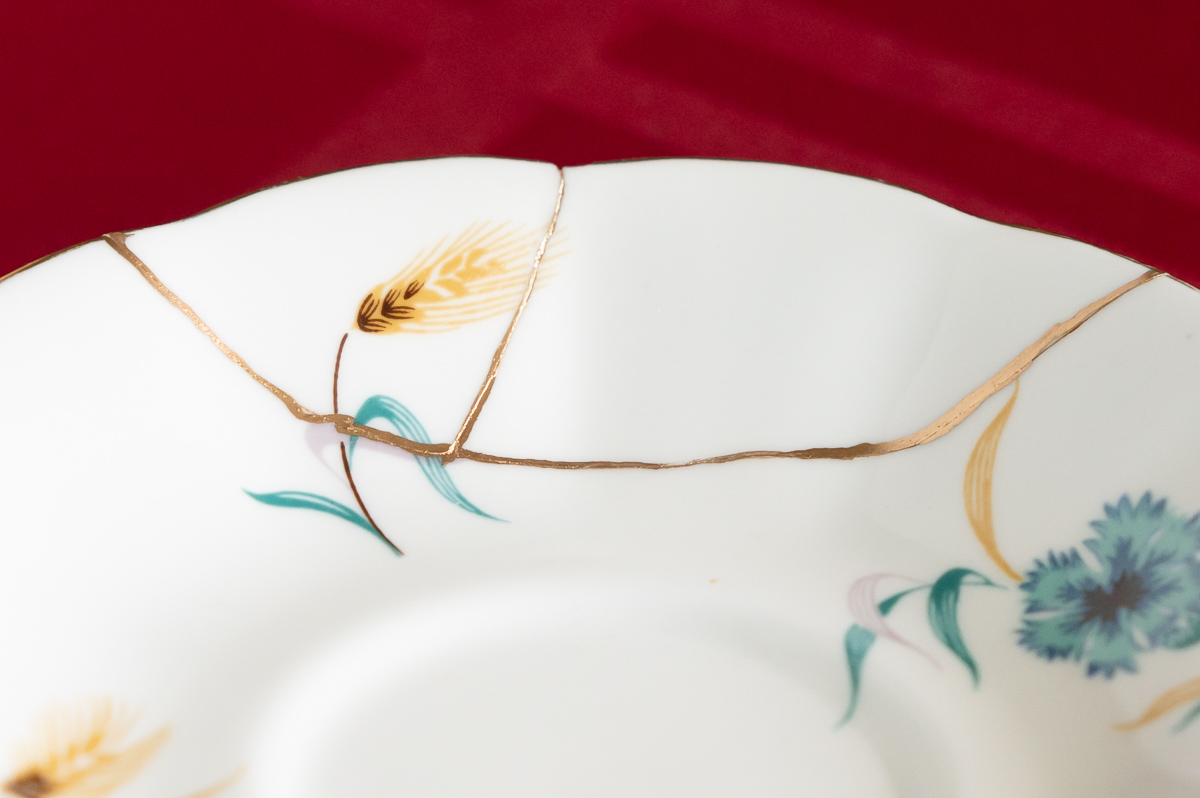The Oxford English Dictionary identifies “redux” as an adjective that means “brought back, restored; experienced or considered for a second time; revisited.” In ancient Rome, Fortuna Redux, thought to be the goddess of chance, was associated with safe homecomings, good fortune, and bountiful blessing.
After posting my June 2024 essay titled Porcelain, a few hours later I received an email message from ceramicist Mark Terry:
Having spent much of last week mending precious work for a former student . . . your article speaks with apt and timely eloquence to the nature of clay—and so many precious things—about brokenness, scars, healing and the way artifacts inspire memories. I appreciated every word. I also wanted to propose that you consider letting me try my hand at mending/kintsugi [your mother’s saucer] for you.[1] I applaud your thoughts about long after-the-fact repair but concur with Mako Fujimura that there might be room to allow the saucer to have its “brokenness redeemed” by the hand of the artist—who of course emulates the creative and restorative work of The Artist in their work. Perhaps the repair of one cup and saucer set might bless you as a monument to memory? Consider it.
The June blogpost explained how, in a moment of adolescent horseplay, I had destroyed my mother’s collection of porcelain tea cups and saucers. It went on to tell a previously untold story of the day, many years after my mother’s death, I grieved her loss most profoundly. Mark was right to notice that I’d made a case for letting my crude repair of the broken saucer remain. Besides, having published the essay, the circle of that story now seemed complete.
But now I had Mark’s unexpected offer to consider. I quickly warmed to my friend’s generous proposal and agreed to have him repair the porcelain saucer. That same message from Mark, a master potter, went on say more about porcelain, its making and meaning:
The porcelain trade was steeped in secret, not least the technique for reaching high enough temperatures to vitrify (transform the clay into stone) and thereby make that magical material useful. Like the mythical relationship between the mulberry trees needed for silkworms, porcelain became known to Westerners as “bone China” when they eventually “cracked the code” and began adding bones to the fuel to increase the carbon content in their fires. All this makes the “ashes to ashes, dust to dust” narrative we use when we reflect on the mortal coil mightily relevant to us potter-types as we think about our clay “bodies,” and every aspect of making and remaking the vessels we shape.

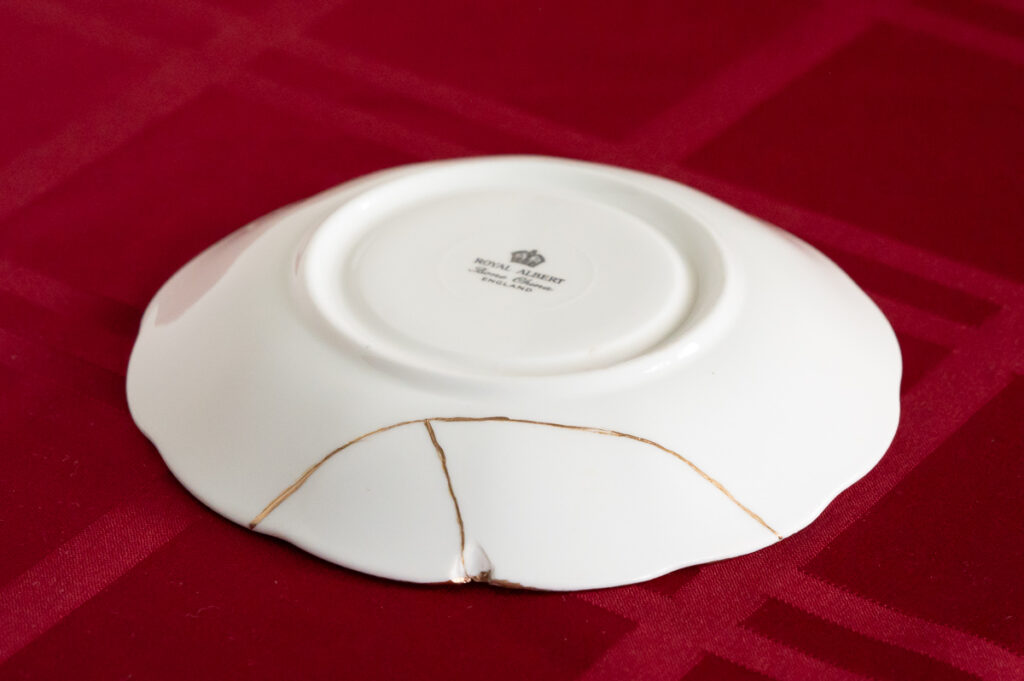
In his book The Gift: Creativity and the Artist in the Modern World, Lewis Hyde explains that “the gift must always move.” My June blogpost generated quite a few comments and here, cited with permission, are portions of three. Painter Bruce Herman wrote, “Such a tender and poignant piece . . . the lines of your writing mirror the broken porcelain itself. There’s a certain kintsugi in the writing . . . golden seams of lovely language and memory.” Then this from spiritual director Fr. Rick Ganz: “I have read, and with fruit, your ‘Porcelain’ piece. . . It got me wondering about the Japanese craft. I wonder whether those master craftsmen ever considered what they were doing as a ‘repair.’ I wonder whether they might have considered what they did as experiencing profoundly the connection between two broken pieces of the world.” And finally, this reflection from installation artist Leslie Iwai: “So many thoughts, the beautiful vessel, the body—our clumsiness, coupled with tenderness and grief.”
In these exchanges regarding the nature of made things, broken, and repaired, the capacity of writing to summon deeper connections, the reality of our embodiment as vessels of being in the world, the gift continued to move.
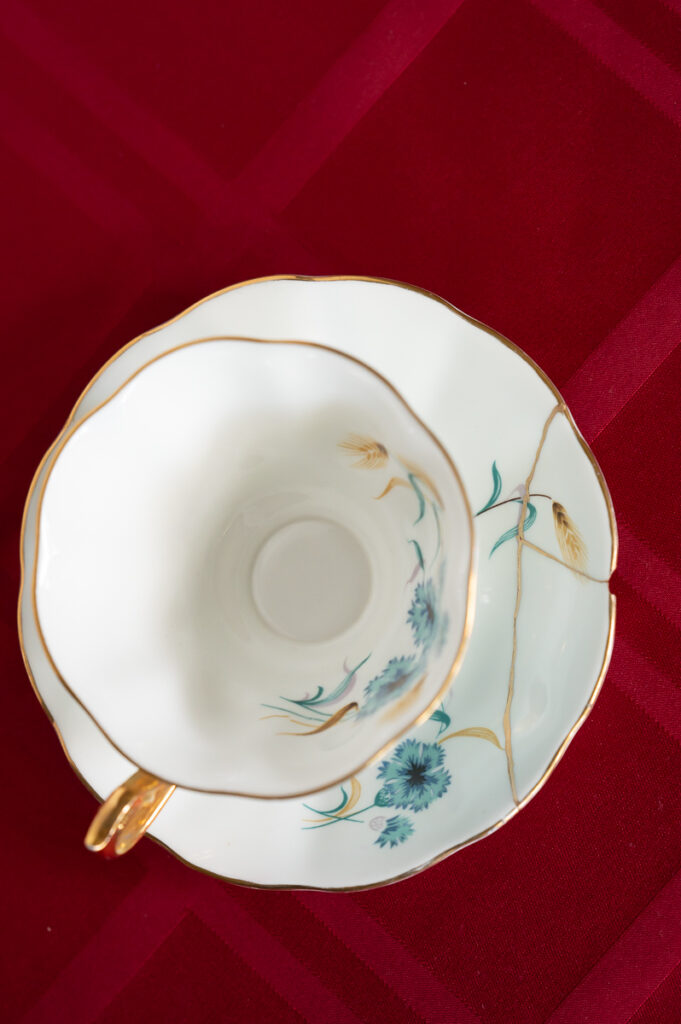
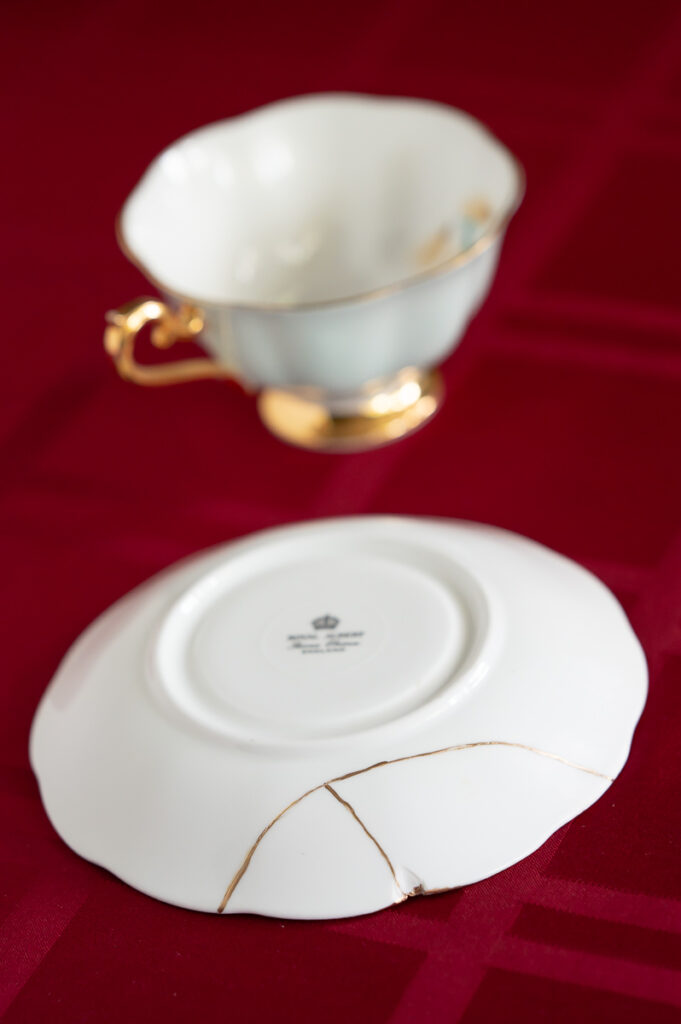
Having settled on the idea of sending the Royal Doulton saucer to Mark for repair, my mind rushed to another broken vessel—an African pot given to my wife, C.K., and me as a wedding gift. That hand-built pot, from Jeff Kern, a groomsman in our wedding, arrived broken. I could not bear to tell Jeff what had happened, nor could I bring myself to toss that handful of earthenware pieces into the trash. So I did my best to repair it, and through 49 years of marriage this smokey-hued vessel has graced one bookshelf or another in six different homes. Could Mark repair it? He agreed that he could and I shipped the pot and the saucer to his studio in Newberg, Oregon. These gifts continued to move.
Amid all of this, I wanted to learn more about the African pot, so I contacted Jeff. He explained that, during med school at UW-Madison, he had served for a short while in a World Health Organization outpost with a mission hospital run by the Mennonites. It was located on the eastern shore of Lake Victoria, outside of Shirati, a small town in Tanzania. In our text exchange, Jeff wrote, “There I picked up some of the local pottery, which was very ‘tribal,’ all functional pieces, and brought them back. If I remember correctly, they were Kikuyu.” In a subsequent message he added, “I truly appreciate functional objects that have artistry to them—the wood firing marks and the incised braiding, someone invested extra time to make this more than just a vessel.”
The gift continued to move. Having received the broken Royal Doulton saucer and crudely repaired tribal vessel, Mark employed an ancient Japanese method to repair them. A month or so later they occupy their appointed places in our home.
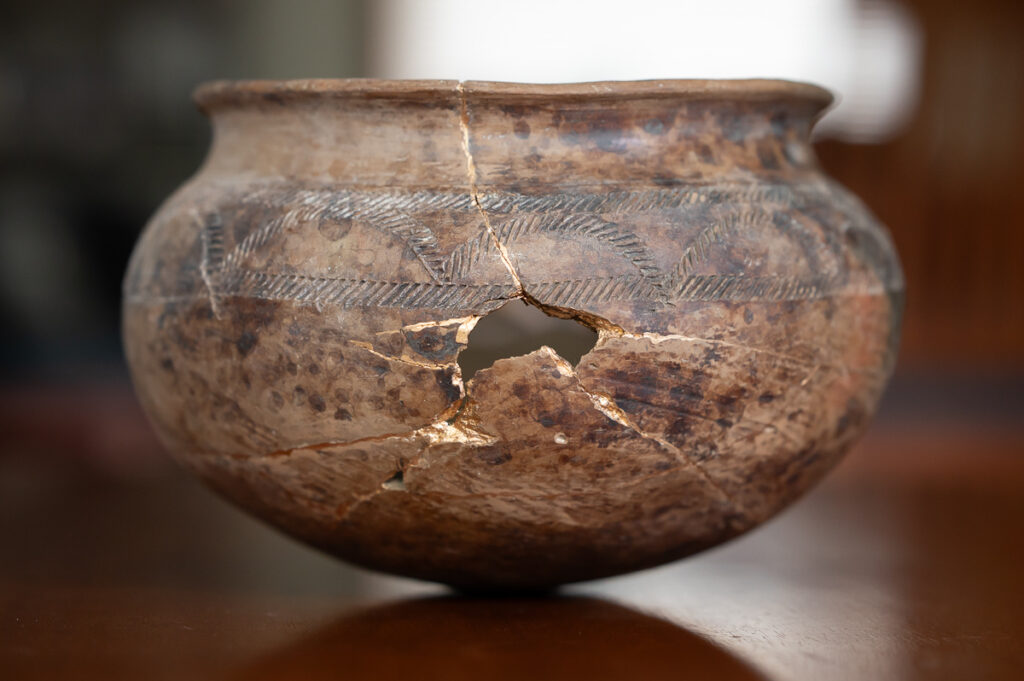
Live long enough, and the ever-present reality of entropy settles in. Bodies age, organizations fail, we are inclined toward fragmentation. But it’s also true that life’s true gifts continue to move. My mother’s porcelain saucer with its new golden seams is the emblem of great loss but also the reminder of all that her life taught me about beauty. The African pot, golden line drawings about its circumference, speaks to my enduring friendship with Jeff. The gifts were moving. An unnamed African tribesman, a British factory worker, an old friend from high school days, a ceramicist at work in his Oregon studio, and you, my readers, joining the story.
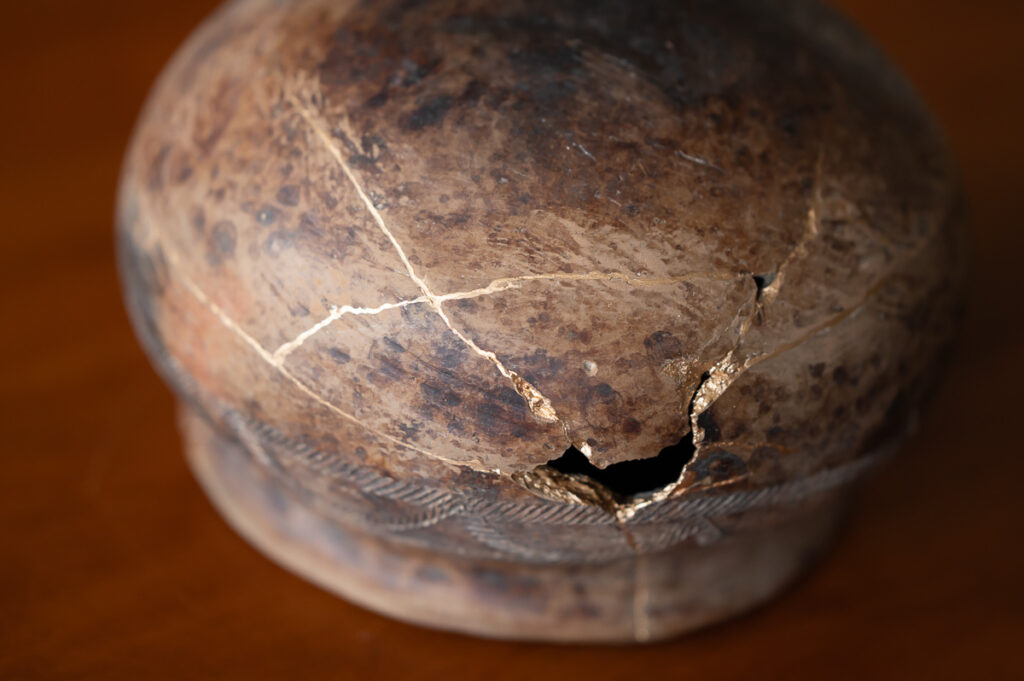
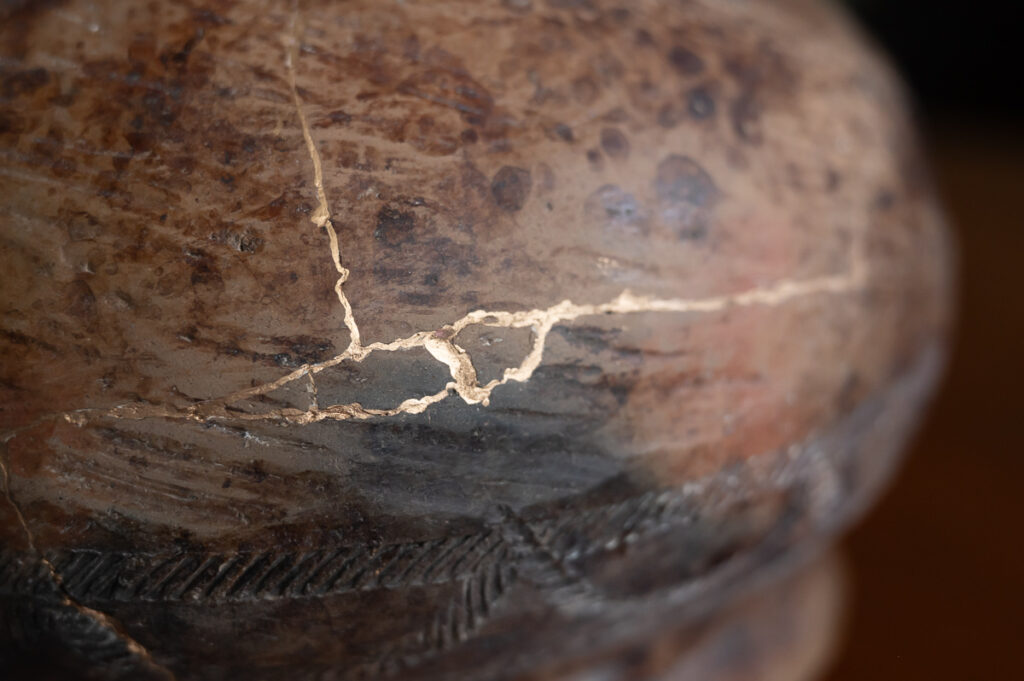
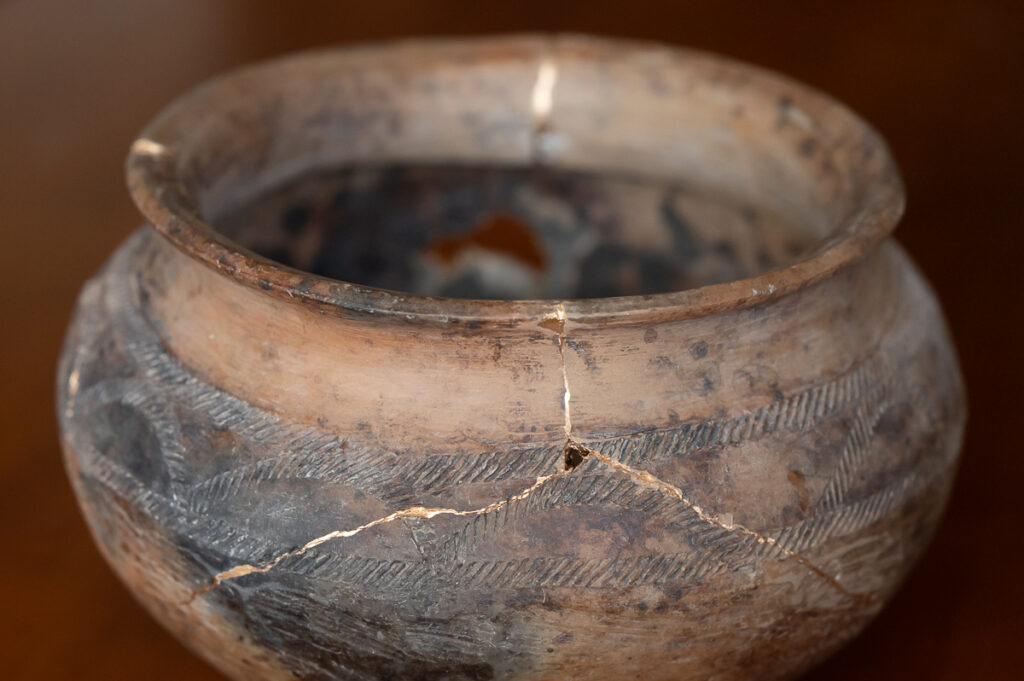

So also had the thoughts of poet Christian Wiman, whose book Zero at the Bone I was reading at the time. “Miroslav [Volf] says some thinkers believe all existence is entwined and some believe there is a crack that runs through creation. For the first group that task of existence is to match one’s mind to that original unity. For the latter the task is one of repair, resistance, and/or rescue.” Winman goes on to say, “Predictably, I find myself in both camps. I think all creation is unified; the expression of this feeling is called faith. And I think a crack runs through all creation; that crack is called consciousness.”[2]
I end with the voice of another friend, writer Deb Davis who, responding to my June blogpost, shared a link to this lovely video by Minnesota-based singer/songwriter Peter Mayer. Japanese Bowl is, I think, a fitting benediction.
Notes:
[1] Kintsugi, meaning “golden joinery,” is also known as Kintsukuroi, “golden repair.” It is the Japanese art of repairing broken pottery with lacquer dusted or mixed with powdered gold, silver, or platinum. Its earliest application may be the late fifteenth century.
[2] Christian Wiman, Zero at the Bone: Fifty Entries Against Despair (New York: Farrar, Straus and Giroux, 2023), 278.
I thank Dawn Anderson for serving as guest editor for this post.

